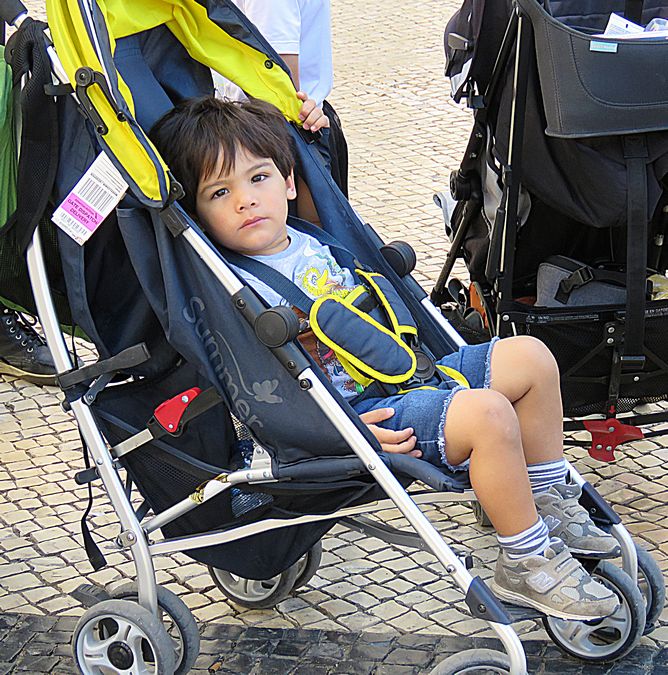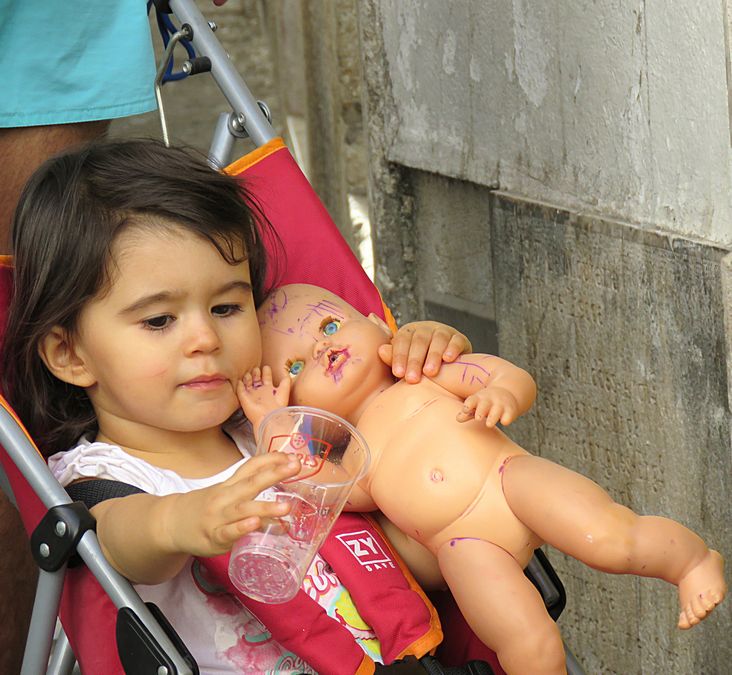Backroads of Iberia: Spanish Paradores & Portuguese Pousadas
September 30 - October 16, 2018
I
took an Overseas Adventure Travel trip to
Portugal and Spain.
Part One: Portugal, Page One - Lisbon, Portugal
Portugal is one of the oldest countries in Europe, with its
territory having been continuously settled, invaded and fought
over since prehistoric times. Pre-Celts, Celts, Carthaginians,
and Romans were followed by the invasions of the Visigoths
and Germanic peoples. It was established as a country during
the Christian reconquest against the Moors,
who had invaded the Iberian Peninsula in 711 AD.
Despite attempts at independence since its foundation
as a country in 868, only after the Battle of Sao Mamede
in 1128, where Portuguese forces led by Afonso Henriques
defeated forces led by his mother, Theresa, Portugal affirmed
its sovereignty and Afonso Henriques called himself Prince of Portugal.
He was later proclaimed King of Portugal.
In the 15th and 16th centuries, Portugal established the first global empire,
becoming one of the world's major economic, political and military powers.
After the 1910 revolution deposed the monarchy, the democratic but unstable
Portuguese First Republic was established, later being superseded
by a right-wing authoritarian regime ruled by Antonio Salazar.
Democracy was restored after the Carnation Revolution in 1974.
Shortly after, independence was granted to almost all its overseas territories.

The Marquis of Pombal Square, a focal point of Lisbon
geographically and historically. The statue honors the Marquis of Pombal,
a statesman who directed the rebuilding of the city after the devastating 1755
earthquake that destroyed much of the city. A lion, symbol of power,
is at his side. The marquis is facing toward the Baixa district, one of the
areas most affected by the earthquake.

A war memorial in tribute to those who died in WWI - on the
Avenida da Liberdade (Liberty Avenue), a wide, tree-lined avenue
that often has festivities and demonstrations.

Some of the original mansions that were preserved from when
the Avenida da Liberdade was created by the Marquis of Pombal.

Baixa, downtown area of Lisbon.
This is the Dona Maria II National Theater.

Rossio or Dom Pedro IV Square in the heart of Lisbon. Since
medieval times, this area has been the center of Lisbon. The
Square is surrounded by outdoor cafes. The statue is King
Pedro IV. The square also has 2 fountains and cobblestone
made of black and white limestone. The Square was rebuilt in
1803 after the 1755 earthquake that destroyed the city.
Pedro IV was the 28th king of Portugal and first emperor of
Brazil.

View of what is left of the 14th century Carmo Convent from
Rossio Square in Baixa.

The Santa Justa Lift, opened in 1902, connects the Baixa area
and Carmo Square where the Convent is located. It's a major
tourist attraction, offering a view of the area.

The Tagus River, where Lisbon is located, flows into the Atlantic.
The 25th of April Bridge is in the background, a suspension bridge connecting
Lisbon, capital of Portugal, to the municipality of Almada on the south bank.
The monument that can barely be seen standing up on the south bank
is Cristo Rei, a tall statue of Christ modelled after the famous statue in
Rio de Janeiro, Brazil.

The Arch of Augusta Street, completed in 1873, a short distance
from the Tagus River. Part of Comercio (Commerce) Square is in
front of it.

Rua Augusta or Augusta Street, paved in Portuguese
cobblestone. It is now a touristic pedestrian street in Baixa,
lined with fashion and souvenir shops, cafes, etc.

Looking toward Baixa area and Tagus River from the top of
Eduardo II Park with monument to the Marquis of Pombal in
the center.

Belem Tower, or the Tower of St Vincent, a fortified tower located in the
Belem neighborhood of Lisbon. It played a significant role in the Portuguese
maritime discoveries in the era of the Age of Discoveries. The tower was
commissioned by King John II to be part of a defense system at the mouth
of the Tagus river and a ceremonial gateway to Lisbon.

Lisbon's Monument to the Discoveries, located along the Tagus River where
ships departed to explore and trade with India and the Orient. It celebrates
the Portuguese Age of Discovery (or Age of Exploration) during the 15th
and 16th centuries. Prince Henry the Navigator is the figure in front, who was
responsible for the early development of Portuguese exploration and maritime
trade with other continents. Other famous explorers are also represented.

Jeronimos Monastery in Belem area and across the street
from the monument shown above. A former monastery, it was
secularized in December 1833 by state decree and its ownership
transferred to a charitable institution. The monastery is a
prominent example of the Portuguese Late Gothic
Manueline style of architecture in Lisbon. Manueline style was
popularized during the reign of Manuel I in early 16th century.

The main church, Santa Maria, and cloister at the Jeronimos
Monastery.

Inside the church

Inside the church

Vasco da Gama tomb inside the Santa Maria Church
He was a Portuguese explorer and the first European to reach
India by sea. His initial voyage to India (1497–1499) was the
first to link Europe and Asia by an ocean route, connecting the
Atlantic and the Indian Oceans and thus, the West and the
Orient. His discovery of the sea route to India opened the way
for an age of global imperialism and for the Portuguese to
establish a long-lasting colonial empire in Asia.

Migrant mother and child in Mouraria neighborhood of Lisbon.
A guide from Renovar a Mouraria, an organization that works
to help migrants in the area, gave us a neighborhood tour. Like
many areas in Lisbon (and in Madrid), it is becoming very
expensive
to live there,
and the neighborhood is
threatened with gentrification.

Neighborhood square in Mouraria area.

Note the tile on the exterior of this apartment building.
Azulejo is a form of Spanish and Portuguese painted tin-glazed
ceramic tilework. Azulejos are found on the interior and exterior
of churches, palaces, ordinary houses, schools, and nowadays,
restaurants, bars and even railways or subway stations.

Child in Mouraria neighborhood of Lisbon

Another child with her doll in same neighborhood

Typical narrow cobblestoned street in Lisbon

Azulejos still are a major aspect of Portuguese architecture.
Many azulejos chronicle major historical and cultural aspects
of Portuguese history.

The ruins of Carmo Convent, Convent of Our Lady of Mount
Carmel, a former Catholic convent. The medieval convent was
ruined during the 1755 Lisbon earthquake. It is the main trace
of the great earthquake still visible in the old city. Now, the ruined
Carmo Church is used as an archaeological museum.

View from Carmo Convent of Lisbon with St. George's Castle on
the hilltop. It is a Moorish castle on a hilltop overlooking the
historic center of Lisbon and Tagus River. The strongly fortified
citadel dates from medieval period of Portuguese history.
Link to Part One, Page Two - Sintra, Portugal
Pat's Home Page